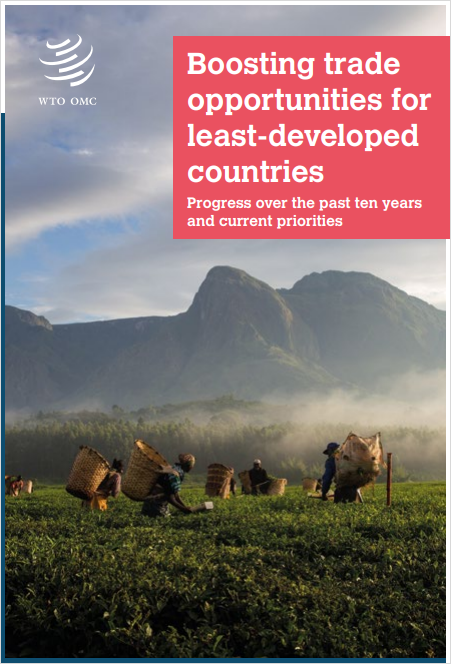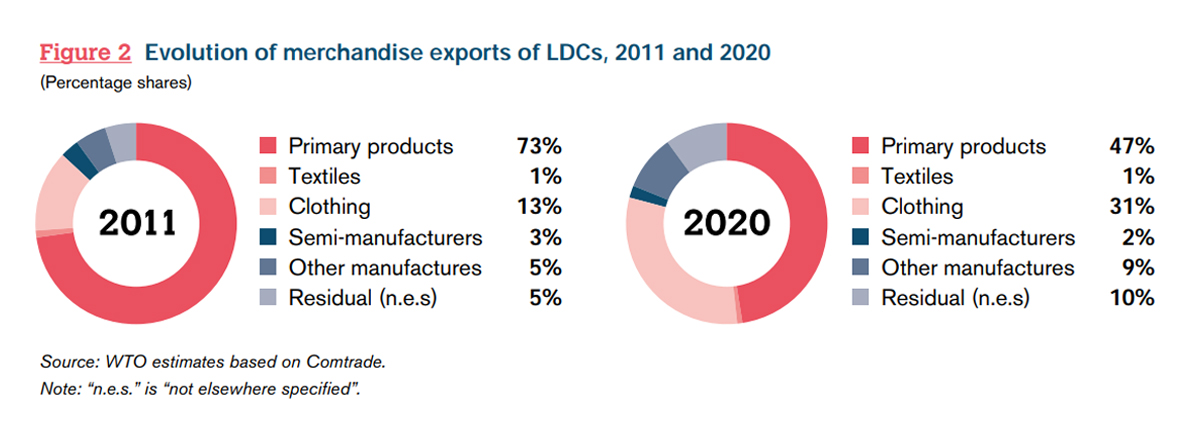How to use it
Boosting trade opportunities for least-developed countries
Published 31 January 2023
The past three years of pandemic, war, and inflation, have been particularly challenging for least developed countries. How can LDCs use trade to strengthen their economies in these challenging times? What more can the international community do to integrate LDCs into the multilateral trading system? The World Trade Organization provides some guidance.
Here’s how to use the WTO report entitled Boosting trade opportunities for least-developed countries: progress over the past ten years and current priorities.
Why is the WTO LDCs report important?
The international community has demonstrated a serious interest in promoting the economic development of LDCs, including through trade, as evidenced by the Istanbul Programme of Action for LDCs from 2011 to 2020. As this decade progresses, it is important to understand what progress, if any, LDCs and the international community have made in expanding LDC participation in trade. The WTO LDCs report provides a summary of these accomplishments and identifies areas for improvements and further work going forward in order to incorporate LDCs fully into the global trading system.
What’s in the WTO LDCs report?
The WTO LDCs report includes four sections followed by statistical annexes:
- LDC Trade Performance from 2011 to 2020;
- LDC Integration into the Multilateral Trading System;
- Building LDC Capacity to Trade;
- LDC Graduation; and
- Annexes with key trade data for each of the 46 LDCs.
How to find the key insights
LDC Trade Performance from 2011 to 2020 | LDC Integration into the Multilateral Trading System | Building LDC Capacity to Trade | LDC Graduation
Chapter I: LDC Trade Performance from 2011 to 2020
- As of 2020, LDCs’ share of global exports was 0.91%, down from 0.95% in 2011; LDCs made up only 1.01% of global merchandise exports and 0.53% of commercial services exports. (pp. 5-7, Figures 1, 3, and 4)
- LDC trade is highly concentrated: 10 LDC exporters accounted for 73% of LDC exports in 2020; most exports went to five major markets: China, the EU, the US, India, and Thailand. (p. 5)
- The largest share of LDC merchandise exports is petroleum-based primary products; clothing exports have increased significantly over the past decade. (p. 5-6, Figure 2)
- Tourism is the primary services export sector for LDCs; LDC commercial services exports dropped by around 40% in 2020 due to Covid’s impact on travel. (p. 7)
Chapter II: LDC Integration into the Multilateral Trading System
- Preferential LDC market access is a key tool for LDC integration into the multilateral trading system; over the past decade, WTO Members have expanded this by adopting full duty-free and quota-free market access, simple and transparent rules of origin and preferential services market access for LDCs. (pp. 9-11, 19)
- Flexible implementation of WTO rules, particularly for intellectual property, have helped LDCs accede to the WTO and supported LDC access to medicines and technologies. (pp. 11-13)
- 35 LDCs are WTO Members; 9 acceded after 1995 of which, 3 have already graduated; 8 more LDCs are in the process of acceding. (p. 12, Box 1)
- The Trade Facilitation Agreement can particularly benefit LDCs by reducing trade costs by up to 16%; LDCs need additional time and support to implement the commitments. (pp. 13-14)
- WTO Members continue to be sensitive to LDC needs in agriculture trade and fisheries subsidies, and to give special and differential treatment in WTO agreements. (pp. 14-17)
- The WTO gives technical assistance to build LDC human and institutional trade capacity. (p. 19)
- The WTO has distributed 30 percent of over US$366.9 billion in Aid for Trade to LDCs, to implement the Istanbul Programme of Action for LDCs. (pp. 19-20)
- The Enhanced Integrated Framework, a partnership among LDCs, former LDCs, donors, and international organizations, has provided US$230 million since 2009 to fund analysis, strengthen LDC trade institutions, and build productive sectors with high export potential. (p. 21)
Chapter IV: LDC Graduation
- LDC graduation is a WTO priority: between 2011 and 2020, 4 LDCs graduated from LDC status. 16 LDCs are in the process of graduating. (pp. 23-24, Figure 6)
- Graduating LDCs face the challenge of sustaining progress they have made once they graduate, in part because of the loss of preferences and special rules related to their LDC status. (pp. 23-25)
- The WTO has produced research and analysis to better understand the issue and identify resources to address it. (pp. 24-25)
Conclusion
The WTO LDCs Report provides a good summary of LDC performance in the multilateral trading system, how the system is structured to include and incorporate their participation, the tools used to provide aid to increase their capacity, and the challenges of graduation. This report serves as a useful starting point for anyone researching how the WTO assists LDCs in using trade as a tool for economic development.
***
Complementary reports and analysis
Hinrich Foundation
- Foreign investment has helped to deliver growth in Southeast Asia – can it also deliver sustainable development?
- Multiple pathways to upgrading in global value chains in Asia
- Trade and development in an age of crisis: Mind the fundamentals
EXTERNAL RESOURCES
- Trade and Development Report 2022: Development Prospects in a Fractured World – UNCTAD
This annual report provides a comprehensive and authoritative analysis of economic trends and policy issues of international concern. - Currency Depreciations Risk Intensifying Food, Energy Crisis in Developing Economies – The World Bank
The report discusses how the shrinking value of the currencies of most developing economies is driving up food and fuel prices in ways that could deepen the food and energy crisis. - Conferences – Least Developed Countries– United Nations
A site comprising all background history, reports, and analysis on LDCs from the United Nations.
© The Hinrich Foundation. See our website Terms and conditions for our copyright and reprint policy. All statements of fact and the views, conclusions and recommendations expressed in this publication are the sole responsibility of the author(s).


